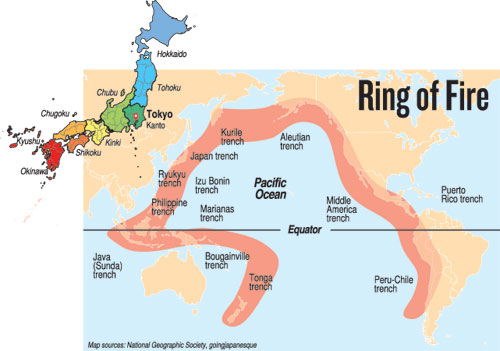Sunday Times 2
Lessons from experiencing an earthquake first hand in Japan
As an English teacher in a Japanese high school I have been living in Japan for the last four and a half years – and I have become used to earthquakes. Occasionally I can feel the earth shaking ever so slightly and I just ignore it. This happens almost every month! Japanese school students are taught from a young age how to deal with earthquakes:
 “Go under your desk and squat, hold the table legs, and don’t panic.” The country is well prepared for earthquakes; modern buildings are being built to withstand tremors and people are being educated about how to prepare an emergency pack and where to go if an earthquake occurs. Emergency shelters are located in school gyms and sporting arenas. Japan even has a little notification that goes off on everyone’s phone warning of an earthquake, with advice on what to do.
“Go under your desk and squat, hold the table legs, and don’t panic.” The country is well prepared for earthquakes; modern buildings are being built to withstand tremors and people are being educated about how to prepare an emergency pack and where to go if an earthquake occurs. Emergency shelters are located in school gyms and sporting arenas. Japan even has a little notification that goes off on everyone’s phone warning of an earthquake, with advice on what to do.
So earthquakes shouldn’t be a problem, right? Wrong. Knowing on paper what you should do and actually having to do it are so, so different…On Monday 18th June at 7.58 am in Takatsuki in the Osaka Prefecture, an earthquake measuring 6.1 on the Richter scale with a hypocentre of 13 kilometres occurred. The hypocentre is where the earthquake originates deep within the earth, while the place where it occurs on the earth’s surface is called the epicentre.
When the earthquake struck, I was getting ready for work. I rang my mother in the morning, sent a quick message to my friend, and was about to leave the house, when, at 7.58 am, my apartment shook so violently that I thought I was going to die. Despite living in the Hyogo Prefecture (which is next to the Osaka Prefecture), I felt these earth-shaking tremors which lasted for about 30 seconds.
For some strange reason I was rational enough to squat on the floor and cover my head with my arms. My glass cabinet containing my crockery flew open of its own accord and showered me with glass, cutting my hand and causing me to bleed. The cup of tea sitting on the table above me fell to the ground, splashing tea all over the rug. Bottles, containers, and papers fell from my desk.
My apartment complex is quite old, and has not been fortified for earthquakes. When would the shaking stop? I couldn’t hold onto anything and as things were falling around me I was trying hard to protect my head…I cried from the shock, and I cried even harder later that day when I heard a nine-year-old girl had died due to a wall falling onto her.
Over 200 people were injured, and 5 deaths occurred from people being crushed by falling objects. Problems associated with earthquakes included aftershocks, fires, landslides, burst water pipes, service disruptions (trains, buses, and closure of expressways), and water, gas and electricity disruptions. Many people were without running water and gas for several days.
Since this was a work day, people were forced to go to work in taxis or on foot, as trains stopped running. Some people could not make it to work or school as trains were delayed for almost eight hours. School children were either given the day off or were kept in school gyms while their school buildings were checked for safety.
Despite earthquakes frequently happening in this beautiful country, each time is as terrifying as the last. The Japanese are a stoic race, and learn to endure hardships from a young age. Instead of talking about their fear they go about their daily lives without bothering other people – and instead, they suffer at night, where anxiety and stress cause them to lose sleep.
Why do earthquakes occur?
The surface of the earth is made of several plates (tectonic plates) that are constantly moving. Earthquakes are caused by the rubbing or knocking of these tectonic plates along a fault line – the place where the surfaces of both plates come into contact with each other. Tsunamis occur when this movement happens under water.
Usually the rubbing of tectonic plates is so gentle that we can’t feel it. It’s only every so often that we will feel it – and when we do, earthquakes can be so severe as to be felt thousands of kilometres from their epicentres. Earthquake activity is measured on the Richter scale (1 – 9) earthquakes registering above 5 can cause damage to buildings.
Japan is located in the Pacific Ring of Fire – an area of the world that experiences almost 90% of the world’s earthquakes and contains 75% of all active volcanos. Japan experiences earthquakes almost every day, but these earthquakes are either felt very slightly, or not at all.
nfortunately, every so often, Japan experiences a huge earthquake that not only kills people, but also destroys buildings and infrastructure.
It was my first big earthquake. It’s been over two weeks now and I still suffer from phantom shaking, where I think the ground is shaking but it’s not. Whenever I hear a loud noise, I get scared and cover my head with my arms. As aftershocks continue to plague the area, all I can do is wait them out – and hope that another big quake does not come on in the near future!
(The writer could be contacted on the following email address Sanjiva.wijesinha@med.monash.edu.au )

